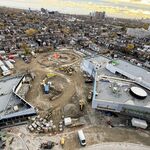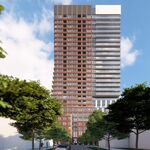As far as we are hijacking this thread.
To a point. But Toronto is far beyond that point.
We reached a point where at Queens U, during good weather, we now have more bikes per hour on College during peak period, than cars per hour,. Some hours have counted well excess of 1000 bikes, while cars in peak period lanes are limited to approximately 800 cars per hour.
Even freeway lanes are limited to 1700 to 2100 cars per hour per lane -- that's about 1 car every 2 seconds. But that's not possible in downtown traffic signalled streets, and congestion collapse occurs far below 1000 cars per hour per lane.
Now, a single subway track can exceed 60,000 ppphpd (Peak People Per Hour Per Direction) in some of the best systems worldwide.
TTC subway carries 40Kppphpd, which matches 20 lanes of 2000 single-driver cars, as seen in this classic 1950s/1960s era advertisement:
View attachment 208025
(Side note: I encourage more transit, but understand why there's the feeling of "I'm keeping my car, over my dead body! Add more lanes, add more lanes...."...
I own a 2011 Hyundai Elantra Touring, baby blue color, car keys dangling, even though I use transit more often and mainly use cars for transit-inconvenient trips, one tankful of gas per month.... though NEVER drive here downtown; the critical pain point passed and now more and more people just want better transit downtown. At some point it becomes a majority in the region, and that filters to the electorate. (Look at the Climate-aware Millenials too)
It's the "New York" and "London UK" mentality: Economy depends on transit improvements more than cars in these ultradensified areas. There's a densification critical mass where car lane value starts devaluing relative to replacement with transit. In a situation where super-densification continues without ability to do any road capacity increases. Megacities are way more livable with transit than being dependant on cars, and you really truly notice that if you visit world cities.
In fact, there are currently enough proposed/approved condos/offices downtown to double the number of towers downtown over the next 15 years. And that's not going to end. We're next to a Great Lake, with lots of eastward/northward/southwards expansion room, in a favoured-country in today's geopolitics/climate, and the pressures of Toronto is going to still be continued superdensification (with only a few pauses for corrections). There is intense pressure in Toronto to keep densifying.
So now you're getting it -- you're seeing where the downtown economy mathematics are going.
As Toronto downtown continues to superdensify, the financial & economic profit pressure (businesses booming downtown) favours turning King into a 60-meter "
low-floor mini equivalent of Calgary C-Train". More commerce, more economy, more business... Sure, a few single-occupant-car-dependent businesses might have difficulty, but the rest of the downtown economy succeeds way more. Even the King Pilot had big undocumented spinoff benefits and indirectly made it much easier for residents to move to places like Liberty Village (and continue densifying there, too). Onwards goes the outwards Toronto densification.
It's the Tokyo Factor, It's the New York Factor, it's the London UK Factor. All World Cities tends to starts converting SOME car lanes into transit because megacities start profiting more when it's impossible to cram any more cars on a lane. Transit in megacities/world cities tend to become the equivalent of the nuclear reactors of people throughput that powers a megacity economy. Toronto is entering the World City League. It is only a few car lanes sacrificed to increase people throughput to power a megacity economy.
The Toronto downtown economic pressures finally overcomes the "I want to keep car lane" mentality, so the pros finally starts outweighing the cons, and then -- eventually -- unable to widen roads further -- Toronto is willing to jettison all vehicles fully away from King streetcar tracks (except at intersections). The dominos are already slowly flipping, and it's already done elsewhere (successful metro-speed metro-frequency non-metro routes that pushes 6-figure-passenger-per-day). Electorate demand, voter demand, politicians start listening -- it's slowly happening. (P.S. How did Transit Pilot happen? Bingo. And Phase 2 will almost definitely domino later this century.)
This is why I am almost willing to bet my mortgage that
within half a century, the King streetcar route is eventually becoming an (approx) ~60-meter level-boarding transit-priority LRT route.





